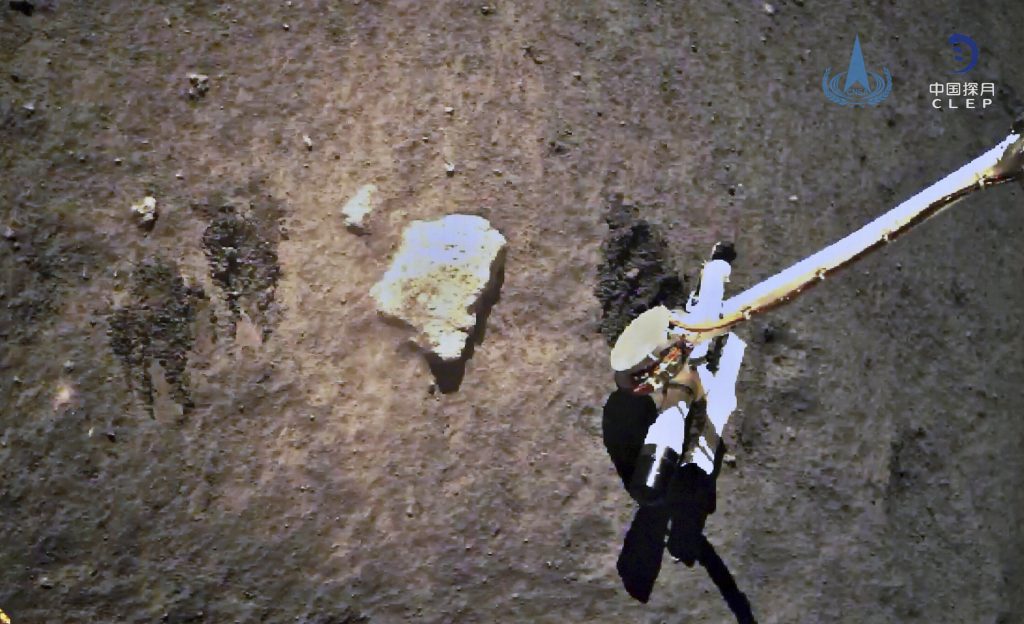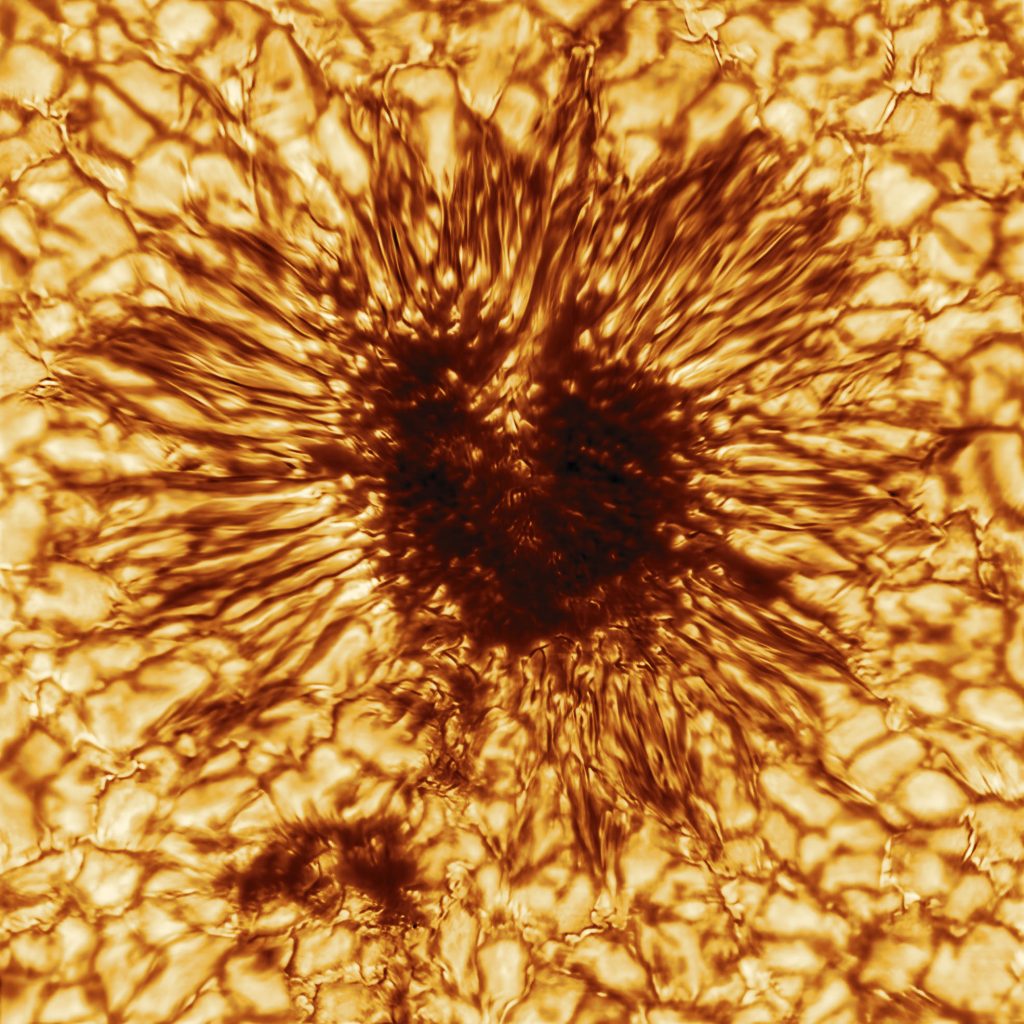Media
Summary
The first sunspot image released by the not-yet-completed Daniel K. Inouye Solar Telescope is highly detailed and a sample of the images to come. Plus, all the sample return missions, how the Sun bends light, and building blocks for organic molecules found in meteorites.
Transcript
This is the Daily Space for today, Tuesday, December 8, 2020. I am your host, Dr. Pamela Gay.
And I am your host, Beth Johnson.
And we are here to put science in your brain.
We often try to have a theme to our news: some thread, however loose, to run through our show and pull everything together.
Today just isn’t that day. All I can promise is we start with the bad news, and things should get better from there.

Yesterday humanity lost one of the great test pilots of the early days of aerospace. Chuck Yeager passed away at age 97. He was a complex person who wasn’t always kind or nice but was, however, one of the best test-pilots of his day, and on October 14, 1947, he became the first person to break the sound barrier. Yeager was responsible for training many of the early astronauts, but because he only had a high school degree, he was ineligible to fly for NASA himself.
While Yeager is best known for his adventures as a test pilot, for most of his career he was a military pilot who flew in WWII, Vietnam, and in Southeast Asia during the troubles between India and Pakistan in the 1970s. He retired in 1975 as a Brigadier General but continued to work with the United States Air Force all the way until Oct 14, 2012, when at age 89 he co-piloted a McDonnell Douglas F-15 eagle on the 65th Anniversary his original breaking of the sound barrier. This may be a good time for a re-watch or re-read of The Right Stuff.
We have seen a few amusingly wrong news reports stating this generated the first-ever sonic boom, but we’d like to point out those happen naturally with things like lightning.
All right, now we need some happier news.
And that happier news comes to us in the first of not one but two sample return stories today.
Back on November 23, we brought live coverage to you of China’s historic Chang’e 5 launch. Chang’e 5 is China’s first lunar sample return mission, and the story may sound familiar. Rocket launches from Earth, spacecraft heads to the Moon, lander drops to the Moon’s surface. Now, instead of humans, the Chinese lander was entirely robotic, picking up samples to bring back for analysis.

On Friday, the ascent stage of the lander blasted off from the surface and successfully docked with the orbiter. Then two kilograms of lunar material was transferred to the reentry portion, and the ascent stage was cut free. Now we wait for a week for the orbiter to hit the right window for returning to Earth.
So far, so good. And congratulations to the Chinese team!
Next up, the craft “will first “bounce” off the Earth’s atmosphere to slow its speed before the reentry vehicle separates and floats down on parachutes to land on the vast steppes of Inner Mongolia, where China’s Shenzhou crewed spaceships have also made their landings.”
If all goes according to plan, the Chinese will be the third nation to bring back lunar rocks. Their ambitious lunar missions to date also include the Chang’e 3 rover and the Chang’e 4 probe, both of which are still operational and sending back data. They have plans for a moonbase, and their own space station is expected to be operational in 2022.
We will continue to cover their efforts as they happen, so stay tuned.
And now for something entirely different.
These past couple of weeks, Sun watchers have been enjoying the first sunspots of solar cycle 25. Historically, solar cycles have been measured from minimum to minimum. On average, the separation between minimum is about eleven years, and many of us learned this is due to the periodic inversion of the Sun’s magnetic field as the poles flip. The thing is, solar cycles can be highly variable in both duration and energy, with some cycles lasting more than fifteen years and the sunspot number varying from tens, to more than 200 between years. The most active periods, historically, were notable for the amazing aurora that their flares and coronal mass ejections (CMEs) generated.

Today, however, we recognize that extreme solar flares and CMEs have the potential to wipe out the power grid and satellites we rely on for weather, communications, and more. Trying to predict the severity of solar flares and of solar maxima, in general, has become the job of space weather forecasters, and like trying to predict hurricane seasons, the consensus of “this will be a bad one” or “this season won’t be too bad” isn’t a very accurate science.
But what if predicting solar cycles could be precise? Well, one team, with a controversial new way of looking at the Sun, thinks maybe it could be, and maybe this upcoming solar cycle will be far harsher than the consensus forecast predicts.
Researchers at the National Center for Atmospheric Research have published an article in Solar Physics describing how solar cycles should be measured based on when magnetic bands cross one another on the solar equator. This work is led by Scott McIntosh and builds on earlier work that looked at the full 22-year solar cycle and used coronal bright points – ephemeral flickers of extreme ultraviolet light in the solar atmosphere – to study the motions of magnetic bands. The bright points migrate from nearer the poles to the equator over about twenty years. According to the prior research, the crossing of the bright points – and the magnetic bands they are tied to – coincides with the emergence of sunspot activity and marks the beginning of a new solar cycle.
This indicator lags behind the solar minimum in time and occurs after sunspots have begun to appear. It can be more precisely measured than our current use of solar minima, and it can be measured as it occurs.
According to McIntosh: When we look back over the 270-year long observational record of terminator events, we see that the longer the time between terminators, the weaker the next cycle.
Study co-author Bob Leamon, adds: And, conversely, the shorter the time between terminators, the stronger the next solar cycle is.
This relationship could prove a bit problematic for our power grid and network of satellites because we just completed a very short solar cycle, and that would mean we’re in for an extreme one in the next few years.
Consensus, however, says that the last cycle was really weak, and the next one will be weak. But consensus could mean a lot of people are wrong, and we’re not going to know until this next cycle gets going. Hold onto your hats people, this could be a spotty ride.
Whatever happens, we are ready to watch it in extreme detail. The Daniel K. Inouye Solar Telescope has released its first-ever image of a sunspot. Taken in January 2020, this sunspot is seen with 2.5 times higher resolution than has been previously achieved, and it allows structures as small as 20 kilometers to be seen. This spot is about 10,000 miles or 16,000 km across. This telescope is located on Maui and is still coming online. It is expected to be fully functional in 2021 and will be here to track all the flickers and flares of whatever happens in the next eleven or so years.
I did say there were two sample return missions. Here is the second.
On December 6, just two days ago, a capsule containing samples of asteroid Ryugu landed in the Australian Outback. The sample may include pieces of the solar system that were likely some of the earliest formed, and scientists are hoping to learn more about our system’s formation and history.

Hayabusa2 orbited Ryugu from June 2018 to November 2019, collecting two samples while there. One was from the topsoil of the asteroid. The other was from an artificial crater created by basically shooting an impactor at the surface, allowing the Japanese Aerospace Exploration Agency (JAXA) to collect material from the subsurface of the asteroid.
The Hayabusa2 mission is Japan’s second sample return mission after Hayabusa, which brought a tiny sample of asteroid Itokawa back in 2010. That mission was full of technical difficulties, and the return was later than planned. Hayabusa2, however, has gone beautifully, with a picture-perfect reentry and landing. As project manager Yuichi Tsuda said: Hayabusa2 is home. We collected the treasure box.
Amazingly, after all this travel, orbiting, and sample collection, the main Hayabusa2 spacecraft isn’t finished. It still has enough fuel to visit another asteroid, and the next target is the asteroid 1998 KY26. This particular asteroid is smaller than Ryugu and spins faster. Hayabusa2 will reach KY26 in July 2031, and no samples will be collected. Instead, the craft will collect data that might help scientists better understand how these asteroids formed, how they stay together, and the potential damage to Earth if we were hit by one.
I’m looking forward to all the science that will be coming out of this mission. Congratulations to JAXA and all involved.
We are about five days away from a total solar eclipse that will be passing over South America. For several years, I’ve been looking forward to amazing images of the Solar Corona shining brightly over some of the world’s greatest landscapes in Patagonia and Chile. While most tourist trips have been canceled, we expect there to still be images coming to us from scientists who are looking to once again recreate Eddington’s amazing images of stars appearing in distorted locations thanks to the light bending actions of the Sun’s gravity.

By taking images when six months apart, when the Sun appears in front of a constellation and when the constellation hangs unblocked in the nighttime sky, astronomers can use precise measurements of stellar positions to map how gravity acts like a lens to bend light, with more bending occurring for stars closer and closer to the edge of the Sun.
The thing is, no matter how many times we do these measurements, there is error, and while the results match expectation, that error leaves room for some other variable to be involved, and it turns out sometimes scientists just forget to account for all the variables.
When light passes through something, whether it be a pane of glass or a cloud of gas, that something will refract, or bend, the light. Our Sun has no distinct surface but rather transitions from a convecting layer to a magnetically active atmosphere that thins with distance. That atmosphere and its associated refraction add just the tiniest of terms, but it is something the Parker Solar Probe may be able to verify in 2025. This work appears in Radio Science and was done by Jacob Fokkema and Peter van den Berg. We now have one more reason to look forward to the 2025 Parker Solar Probe observations and one more reminder that there is often room for one more thing in your observations’ error bars.
Finally, we bring you the news that a cooperative Japanese-US team of scientists has found an important building block for organic molecules in meteorites.
The article is published in Nature Communications with lead author Yasuhiro Oba, and the work details the presence of hexamethylenetetramine (HMT) in three different carbon-rich meteorites. (And unlike the last time I had to say a long chemical name on stream, I did this one to myself.)

Of course, what is found in meteorites means it’s also likely found in asteroids, and we consider these meteorites to potentially be at least part of the origin of life here on Earth. Per the press release: If some asteroids were warm enough and had liquid water, HMT could have broken down to provide building blocks that in turn reacted to make other important biological molecules which have been found in meteorites, including amino acids. Some types of amino acids are used by life to make proteins, which are used to build structures like hair and nails, or to speed up and regulate chemical reactions.
The press release goes on to explain: Experimental models have shown that a combination of water, ammonia and methanol, when subjected to photochemical and thermal conditions common in extraterrestrial environments, give rise to a number of organic compounds, the most common of which is HMT. Interstellar ice is rich in methanol. Hypothetically, HMT should be common in water-containing extraterrestrial materials, but, until this study, it had not been detected.
However, it should be noted, again, from the press release: While they were unable to make definitive conclusions in this study, the discovery of HMT and its derivatives in these meteorites will lead to future experiments to understand the origin and chemical formation processes of amino acids and other prebiotic compounds in extraterrestrial environments.
This discovery is really cool. That’s my professional take on it. Really. Cool. We continue to get closer and closer to understanding where life came from, and in doing so, we gather more information on what to look for elsewhere in the galaxy. Some day, we will find we are not alone.
This has been the Daily Space.
Learn More
Chuck Yeager, 1st to break the sound barrier, dies at 97
Chinese probe orbiting the Moon with Earth-bound samples
New Sunspot Cycle Could Be One of the Strongest on Record
- NCAR press release
- NSO press release
- “Overlapping Magnetic Activity Cycles and the Sunspot Number: Forecasting Sunspot Cycle 25 Amplitude,” Scott W. McIntosh et al., 2020 Nov 24, Solar Physics.
- “The Daniel K. Inouye Solar Telescope – Observatory Overview,” Thomas R. Rimmele, Mark Warner, Charles White, 2020 Dec 4, Solar Physics.
Hayabusa2 Capsule Returns Asteroid Ryugu Dust to Earth
A Better Understanding of How the Sun Bends Light
- Eos article
- “On the Electromagnetic Propagation Paths and Wavefronts in the Vicinity of a Refractive Object,” Jacob T. Fokkema and Peter M. van den Berg, 2020 Nov 15, Radio Science.
Key building block for organic molecules discovered in meteorites
- University of Hokkaido press release
- “Extraterrestrial hexamethylenetetramine in meteorites—a precursor of prebiotic chemistry in the inner solar system,” Yasuhiro Oba et al., 2020 Dec 7, Nature Communications.
Credits
Written by Pamela Gay and Beth Johnson
Hosted by Pamela Gay and Beth Johnson
Audio and Video Editing by Ally Pelphrey
Content Editing by Beth Johnson
Intro and Outro music by Kevin MacLeod, https://incompetech.com/music/


 We record most shows live, on Twitch. Follow us today to get alerts when we go live.
We record most shows live, on Twitch. Follow us today to get alerts when we go live.